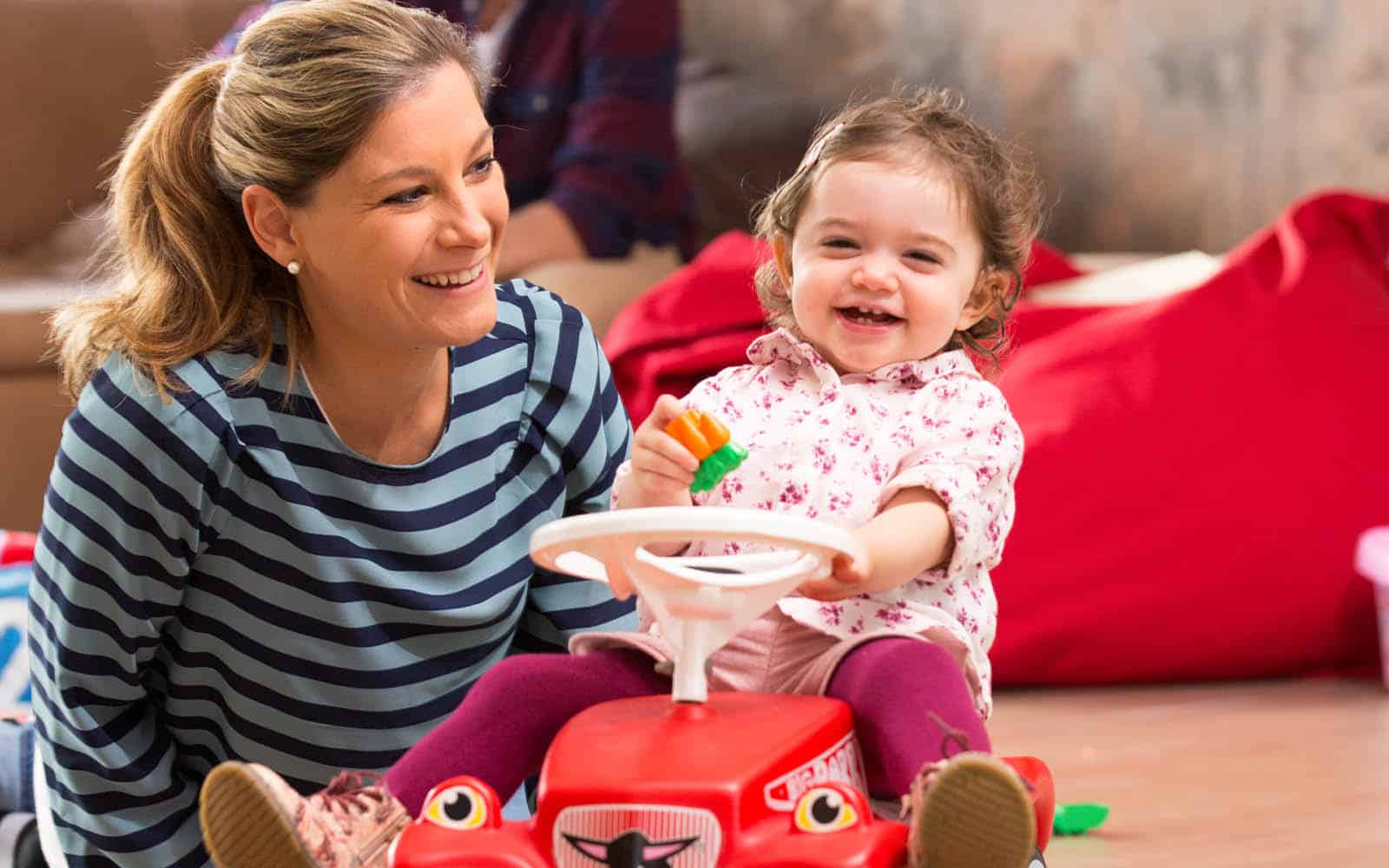
Donna Sperandio
Published Apr 02, 2024
Play Sounds: A Gateway to Listening and Language Development
Play sounds can not only be used capture young children’s listening attention. They can also be a highly effective way to help children learn to process auditory information. By integrating them into your auditory rehabilitation practice, you can help kick-start their listening and language development while having fun.

When young children are learning to pay attention to and understand the auditory information they receive with their cochlear implants or hearing aids, it is important to be able to catch and keep their attention with fun and interesting sounds. In fact, play sounds can be used to promote a child’s ability to detect, discriminate, and identify sounds across all speech frequencies. Estabrooks, W. (Ed.). (2012) 101 Frequently Asked Questions About Auditory-Verbal Practice. Alexander Graham Bell Association for the Deaf and Hard of Hearing.[1] This makes play sounds a valuable tool at this crucial time for listening and language development.
How to Use Play Sounds in Pediatric Speech-Language Therapy
Play sounds are easier to say than some real words, so they can be a good way to get a child to start talking. For example, the sound “aaah” is often used to represent an airplane. It is much easier for an early talker to say “aaah” than to say “airplane.” When a child wants to be picked up, they might be able to say “up up” before they are able to say “lift me up.”
What Is a Play Sound?
A play sound, sometimes called a “learning to listen sound,” is a fun sound we use to represent an object or action in a child’s environment that might interest them. These include onomatopoeic sounds, ideophones—words that illustrate what they mean—and simple words and phrases. Estabrooks, W., MacIver-Lux, K., & Rhoades, E. (Eds.). (2016) Auditory-Verbal Therapy: For Young Children with Hearing Loss and Their Families, and the Practitioners Who Guide Them. Plural Publishing.[2]
Examples in English include: “beep beep” for a car, “woof woof” for a dog, “up up up” for the action of being picked up or walking up the stairs, and “ow!” for being hurt.
Appropriate sounds will differ between languages. In English, a dog says “woof woof,” in Spanish “guau-guag,” in Swedish “voff voff,” and in Japanese “wan-wan.”
Getting Started With Play Sounds for Cochlear Implant Recipients
Begin by exposing the child to a range of these sounds in a repetitive and meaningful way. At first, the main aim is to get the child to notice the sound. They might turn their head to search for the source of the sound, look up towards the person who said it, or pause what they were doing briefly. It is best not to say these sounds in isolation. Instead, simply add them to the enriched language we use when speaking to children with cochlear implants or hearing devices.
After a child has been hearing and listening to play sounds for some time, they typically notice the difference between the sounds and begin to attach meaning to each sound. At this stage, the child may look at or pick up the correct animal from their toys when they hear, for example, the cat sound “meow.” Or they might show they heard and understood “up up up” by lifting their arms up. By playing with a toy and hearing the sound repeatedly, the child associates the repeated sound with the object. Estabrooks, W., McCaffrey Morrison, H., & MacIver-Lux, K. (2020). Auditory-Verbal Therapy: Science, Research, and Practice. Plural Publishing.[3]
Developing a Child’s Auditory Feedback Loop
Another exciting development we look for is children attempting to imitate sounds. At first, the imitation probably won’t sound perfect. For example, they might say “ee ee” instead of “beep beep.” Children don’t speak perfectly when they first start. But if we can hear the suprasegmental patterns of the play sound in what they say, this shows the development of their auditory feedback loop—the ability to match what they say to what they hear. This is an excellent first step towards their first words.
Get the Most Out of Play Sounds in Therapy
- Start by selecting a small range of sounds to focus on. Choose sounds that will occur often in the child’s daily routines. If the family has a cat at home, then the cat sound “meow” would be a great one to choose. If there are stairs in the child’s house, be sure to include “up up up.”
- Always use the real word for the toy or object along with the Play Sound. For example, when playing with a dog toy you might say “oh here’s the dog who says ‘woof woof’.”
- After you say the sound, make sure you pause to allow the child a chance to imitate the sound.
Integrate Play Sounds Into Aural Rehabilitation With Listen and Play
MED-EL has a helpful resource to give you ideas about how to start using Play Sounds. Listen and Play consists of a poster and 20 illustrated cards. The poster outlines the importance of early interaction and includes practical ideas for activities to use during early interactions with infants and toddlers. It is available in English, French, and German.
The illustrated cards show familiar sounds and phrases matched with everyday objects and actions. The cards offer the sound or phrase in English and include suggestions in other languages as well.
With the help of these tips and resources, you can make the most of play sounds in auditory rehabilitation with infants and toddlers. On our rehabilitation downloads page, you can also find many other rehabilitation resources for children.
References
-
[1]
Estabrooks, W. (Ed.). (2012) 101 Frequently Asked Questions About Auditory-Verbal Practice. Alexander Graham Bell Association for the Deaf and Hard of Hearing.
-
[2]
Estabrooks, W., MacIver-Lux, K., & Rhoades, E. (Eds.). (2016) Auditory-Verbal Therapy: For Young Children with Hearing Loss and Their Families, and the Practitioners Who Guide Them. Plural Publishing.
-
[3]
Estabrooks, W., McCaffrey Morrison, H., & MacIver-Lux, K. (2020). Auditory-Verbal Therapy: Science, Research, and Practice. Plural Publishing.
References

Donna Sperandio
Donna Sperandio is a Teacher of the Deaf and a Senior Rehabilitation Manager at MED-EL. She provides training and mentoring support for professionals working in the field of hearing loss and hearing implants, mainly in the Southeast Asia region.
Was this article helpful?
Thanks for your feedback.
Sign up for newsletter below for more.
Thanks for your feedback.
Please leave your message below.
CTA Form Success Message
Send us a message
Field is required
John Doe
Field is required
name@mail.com
Field is required
What do you think?
The content on this website is for general informational purposes only and should not be taken as medical advice. Please contact your doctor or hearing specialist to learn what type of hearing solution is suitable for your specific needs. Not all products, features, or indications shown are approved in all countries.

Donna Sperandio
Donna Sperandio is a Teacher of the Deaf and a Senior Rehabilitation Manager at MED-EL. She provides training and mentoring support for professionals working in the field of hearing loss and hearing implants, mainly in the Southeast Asia region.

Donna Sperandio
Donna Sperandio is a Teacher of the Deaf and a Senior Rehabilitation Manager at MED-EL. She provides training and mentoring support for professionals working in the field of hearing loss and hearing implants, mainly in the Southeast Asia region.



